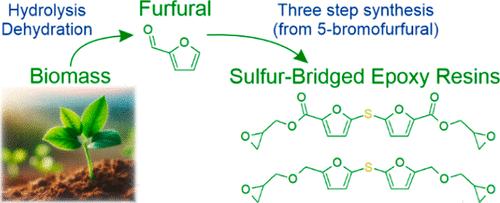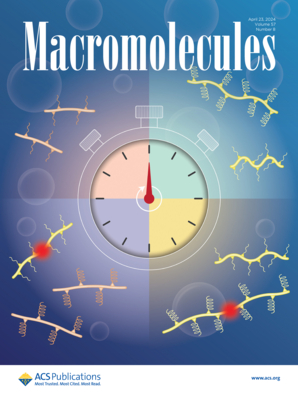Renewable Furfural-Based Sulfur-Bridged Epoxy Resins with Excellent Adhesive Properties
IF 5.1
1区 化学
Q1 POLYMER SCIENCE
引用次数: 0
Abstract
The increasing interest in reducing the dependence on fossil-based resources by searching and replacing them with renewable biobased sources has intensified in both industrial and academic sectors. Especially, lignocellulose-based biomass can be utilized in the production of many aromatic platform chemicals suitable as substitutes for known fossil-based chemicals. For example, cellulose-derived 5-(hydroxymethyl)furfural has been utilized successfully for the aforementioned purposes. On the other hand, hemicellulose-derived furfural has received rather minor attention, even though recent studies show various excellent results in applications especially utilizing furfural. In this work, two novel furfural-derived epoxy resins were synthesized. Comparative studies were conducted with commercially available and widely used fossil-based epoxy resin, diglycidyl ether of bisphenol A. Resins were cured with methylhexahydrophthalic anhydride with optimized amounts of the 2-ethyl-4-methylimidazole initiator. Curing behaviors were studied with differential scanning calorimetry while thermomechanical properties were evaluated using dynamic mechanical analysis and thermal stabilities with thermogravimetric analysis. Adhesion strengths were tested with single-lap joint steel plate samples using a tensile tester. Tensile testing was also carried out for dog-bone-shaped resin specimens. Lastly, the water absorptions were evaluated through immersion in water. Results showed that the synthesized bioresins have great potential to replace diglycidyl ether of bisphenol A in various applications.

具有优异粘合性能的可再生糠醛基硫桥环氧树脂
工业界和学术界对通过寻找和使用可再生生物资源来减少对化石资源的依赖越来越感兴趣。特别是,以木质纤维素为基础的生物质可用于生产许多芳香族平台化学品,适合作为已知化石基化学品的替代品。例如,纤维素衍生的 5-(羟甲基)糠醛已成功用于上述目的。另一方面,半纤维素衍生的糠醛却很少受到关注,尽管最近的研究表明,特别是在利用糠醛的应用方面取得了各种优异的成果。本研究合成了两种新型糠醛衍生环氧树脂。树脂用甲基六氢邻苯二甲酸酐和优化量的 2-乙基-4-甲基咪唑引发剂固化。使用差示扫描量热法研究了固化行为,使用动态机械分析评估了热机械性能,使用热重分析评估了热稳定性。使用拉伸试验机测试了单搭接钢板样品的粘合强度。还对狗骨形树脂试样进行了拉伸测试。最后,通过浸泡在水中对吸水性进行了评估。结果表明,合成的生物树脂具有在各种应用中替代双酚 A 二缩水甘油醚的巨大潜力。
本文章由计算机程序翻译,如有差异,请以英文原文为准。
求助全文
约1分钟内获得全文
求助全文
来源期刊

Macromolecules
工程技术-高分子科学
CiteScore
9.30
自引率
16.40%
发文量
942
审稿时长
2 months
期刊介绍:
Macromolecules publishes original, fundamental, and impactful research on all aspects of polymer science. Topics of interest include synthesis (e.g., controlled polymerizations, polymerization catalysis, post polymerization modification, new monomer structures and polymer architectures, and polymerization mechanisms/kinetics analysis); phase behavior, thermodynamics, dynamic, and ordering/disordering phenomena (e.g., self-assembly, gelation, crystallization, solution/melt/solid-state characteristics); structure and properties (e.g., mechanical and rheological properties, surface/interfacial characteristics, electronic and transport properties); new state of the art characterization (e.g., spectroscopy, scattering, microscopy, rheology), simulation (e.g., Monte Carlo, molecular dynamics, multi-scale/coarse-grained modeling), and theoretical methods. Renewable/sustainable polymers, polymer networks, responsive polymers, electro-, magneto- and opto-active macromolecules, inorganic polymers, charge-transporting polymers (ion-containing, semiconducting, and conducting), nanostructured polymers, and polymer composites are also of interest. Typical papers published in Macromolecules showcase important and innovative concepts, experimental methods/observations, and theoretical/computational approaches that demonstrate a fundamental advance in the understanding of polymers.
 求助内容:
求助内容: 应助结果提醒方式:
应助结果提醒方式:


